| Cynops pyrrhogaster | |||||||||
| Japanese Fire-bellied Newt | |||||||||
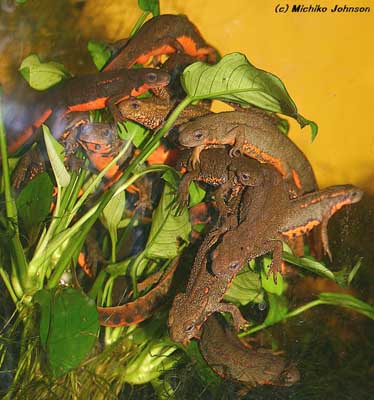
|
|
||||||||
Description
A medium sized newt (9 - 13 cm; 3.5 - 5.5 inches) with distinct parotoid glands, rough skin, and an arched back. Coloration is chocolate brown to black above occasionally with red specks or spots along the dorso-lateral ridges and an orange to crimson colored belly with darker markings. The markings on the belly are highly variable and can be spots, blotches, wavy lines, or reticulations. Males can be distinguished from females by their swollen cloacas, and breeding males' tails develop a purplish or bluish iridescent sheen and a small filament at the tip (absent in some races). Breeding males also develop a smoother skin during the breeding season.
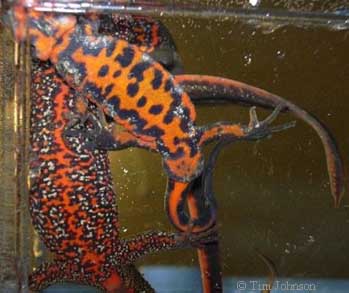 C. pyrrhogaster Sasayame female (left) and male (right) with white speckling on the belly. |
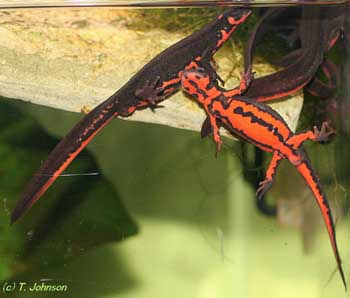
|
There are 6 "races" or subspecies of Cynops pyrrhogaster, each having unique coloration and
morphological traits and will be described below. A few
of these races have been shown to be genetically distinct
as well as reproductively separate along zones of
contact, so this may lead to Cynops pyrrhogaster being
divided up into two or more distinct species.
This species is often confused with the Chinese firebellied newt, Cynops orientalis. To add to the
confusion, C. orientalis is often labeled and sold as Japanese firebellies. The main differences between these two
species are the shape of the tail, skin texture, body
shape, and overall size. Japanese firebellies grow much
larger and are more robust as well as having a more
granular skin texture. The tail of C. pyrrhogaster is
comparatively tapered and pointed unlike the relatively
blunt or rounded tail of the Chinese firebellied newt.
Also, C. pyrrhogaster has an arched back compared to the
flattened back of C. orientalis.
Natural Range and Habitat
Japan: Islands of Honshu, Shikoku, and Kyushu. It inhabits ponds, ditches, slow stream pools, small lakes, and almost any body of still, clear water it can find.
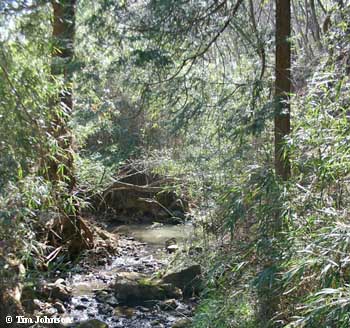 C. pyrrhogaster habitat on the outskirts of Tokyo, Japan. |
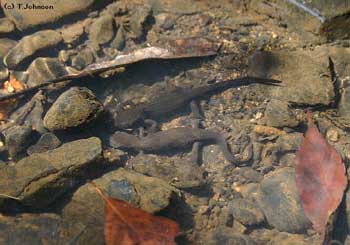 C. pyrrhogaster in native habitat. |
Housing
A densely planted aquarium with a small land area is needed. These newts range from almost entirely aquatic to semi-aquatic depending on particular populations (races) and individuals. Studies have shown that some remain terrestrial for the majority of the year and only become aquatic during the breeding season much like Triturus newts. In captivity they can be treated as essentially aquatic but a land area should be given. It can be as simple as a large rock which breaks the surface of the water by a few inches or a more elaborate, planted land area. These newts seem to appreciate dense stands of aquatic plants so the more plants the better. In the wild they are exposed to a wide temperature range and seem to be far more tolerant of temperatures in the mid to high 70s F than most other newts. However, if given a choice, wild newts seem to prefer cooler waters so efforts should be made to keep their water in the range of 60-74F (18-21C). If possible, cool the water by 10-15 degrees F (5-8 C) in the winter to help approximate seasonal changes as well. Many experienced hobbyists regularly let water temperatures reach the high 70s F for summer temperatures without any ill effects whatsoever, and even have them breed. Yet many others (myself included) have kept them below 70F (21C) with great results as well, so an individual judgment call must be made as to what temperature advice to heed. The closely related Sword-tailed newt (Cynops ensicauda ssp.) is also regularly kept and bred in warmer water. However, from my own observations and success with this species, I cannot recommend temperatures above 74F (23C) but clearly recognize this as a valid point of debate. Japanese firebellies do seem extraordinarily hardy and resistant to such temperatures compared to other species, but keeping newts at high temperatures can potentially stress the newts and make them more likely to succumb to diseases and infections.
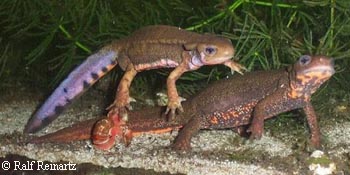 A breeding pair. Male has blue tail stripe that occurs only during breeding season. |
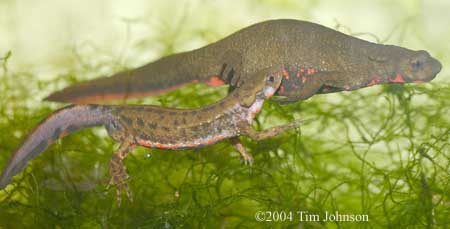 Courtship. |
Feeding
Feeds on a variety of invertebrate prey in the wild. Will feed on an assortment of live and non-living foods in captivity: earthworms, chopped nightcrawlers, bloodworms (live and frozen), mosquito larvae, glassworms, glass/ghost shrimp, lean strips of beefheart, freeze-dried tubifex cubes. While many will eat commercial "newt-pellets", many will not and if your animals do not appear interested in them, try something else.Many try to feed this species guppies and other small fish. While these newts do indeed occasionally catch small fish in captivity (I have witnessed this many times myself), they are not particularly adept at it or adapted to it the way Pachytriton spp. (paddletails) newts seem to be. There are also very real concerns with the fish introducing parasites and fungal and bacterial infections and one should carefully consider this before using feeder guppies.
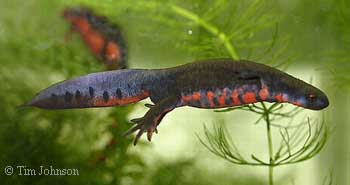 Male in breeding dress. |
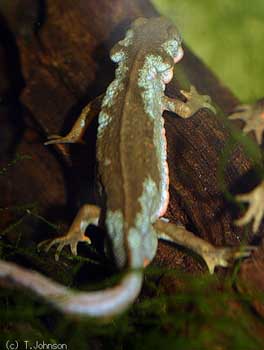 Male with unusual breeding coloration. |
Breeding
At the onset of breeding, males develop smoother skin, a thin tail filament at the tip of the tail, and patches of bluish or purplish sheen along the tail and body. Courting males actively pursue females and compete for their attention by ramming them, blocking their path, and fanning their tail in the direction of the female. Tail fanning is a method of wafting pheromones towards the female. A female can lay up to 200 eggs in a breeding season. When possible, eggs are folded between the leaves of aquatic plants. The eggs hatch approximately 20 days after being laid (depending on temperature) and the larvae usually metamorphose about 3-5 months after.
Metamorphosed juveniles often have a yellow to reddish dorsal stripe and are terrestrial for 1 to 3 years before returning to the water as sexually mature adults. This time can be shortened in captivity by increased feeding. Juveniles will eat whiteworms, pinhead crickets, fruitflies, small earthworms, small waxworms, and other tiny prey.
Hibernation does not appear to be essential to breeding and many keepers (including myself) report these newts breeding even when kept at household temperatures year-round. However, reducing the temperature in the tank by about 10-15 degrees F during the winter undoubtedly promotes breeding activity and is recommended.
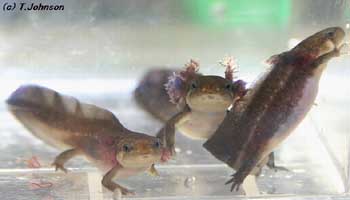 Larvae. |
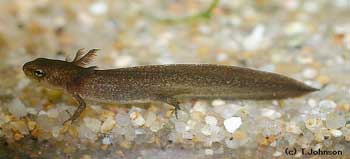 Larva. |
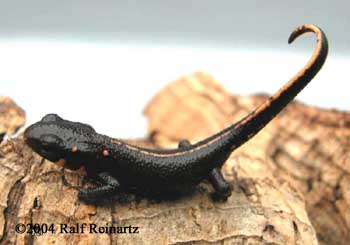 Juvenile, taking a defensive posture. |
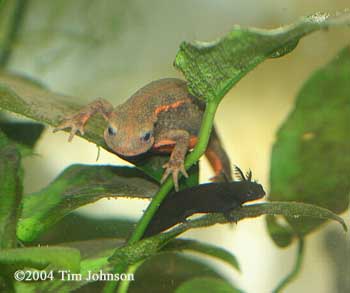 Adult with larva. |
Subspecies or "races"
Unless you know for a fact where a newt was collected, it's virtually impossible to say with any certainty which race it belongs to. Many populations within a race's geographic area display color patterns of other races. Here are some guidelines, as given by Robert Thorn in 1968, if you'd like to guess which race yours belongs to. Although they are quite dated, they can still offer some insight for the person who is curious. Also, a few of the races below may have gone extinct due to development or are no longer considered valid depending on who you ask.
*Hiroshima race:
Distribution - Islands of Kyushu, Shikoku, Oki, and the
Chugoku Region of Honshu.
This subspecies is characterized by having rounded spots or blotches on the belly with some individuals lacking black markings altogether.
*Sasayama or Tamba race:
Distribution - Eastern Chugoku, area of Kinki.
This subspecies has two irregular black lines on a
carmine red belly. Often there are whitish flecks
interspersed on the black lines and whitish spots or
flecks along the sides of the body. Of particular
interest is a courtship behavior: the males place one
hind leg on the neck of a female while fanning
their tails.
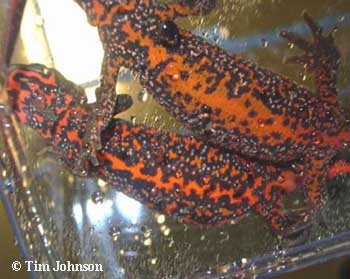 C. pyrrhogaster Sasayama. |
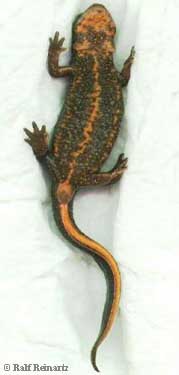 C. pyrrhogaster Sasayama. |
*Atsumi race:
Distribution - Atsumi peninsula (Southeast of the city of
Nagoya).
This is a relatively small race with a high tail fin and has an irregular red dorsal stripe and two irregular lines of red dots on either side of the back. Breeding males lack the purplish tail colors but have a very distinct tail filament. This species will also sometimes place a hind leg on the neck of the female while fanning the tail during courtship and tends to breed at night.
*Kanto race:
Distribution - The Tokyo Plain region of Honshu.
This subspecies has a short but relatively high tail with a blunt tail end. On either side of the belly is a broad black stripe with contains a smaller continuous or discontinuous red stripe, as well as a large continuous red stripe down the center of the belly. Females often nudge or bite the males during courtship.
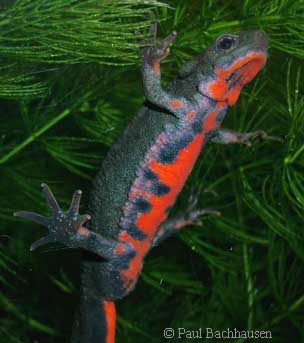 C. pyrrhogaster Kanto. |
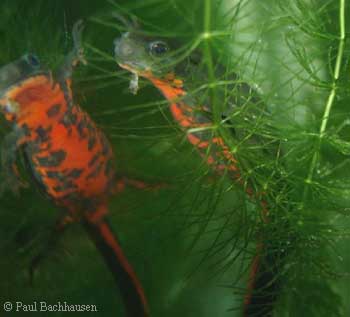 C. pyrrhogaster Kanto. |
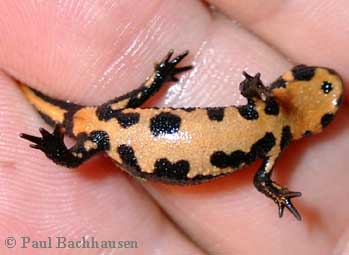 Juvenile C. pyrrhogaster Kanto. |
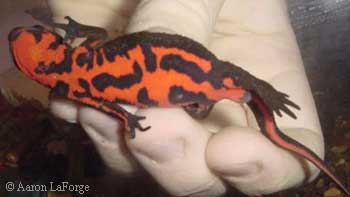 C. pyrrhogaster Kanto. |
*Touhoku race:
Distribution - Northern parts of Honshu.
This race is perhaps the largest in terms of body size. The belly has a large amount of black, undulating flecks and lines, especially on the sides of the belly.
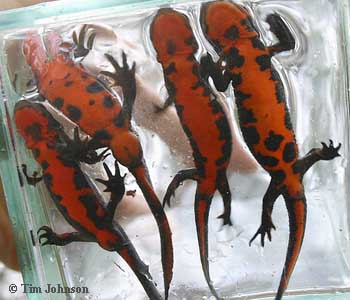
C. pyrrhogaster Touhoku.
*"Intermediate" race:
Distribution - Central Honshu.
Black markings on the belly highly variable.
References
Hayashi, Terutake, and Matsui, Masafumi. (1990). Genetic differentiations within and between two local races of the Japanese newt, Cynops pyrrhogaster, in eastern Japan. Herpetologica. 46: 423-430.
Maranouchi, Junsuke, Hiroaki Ueda and Osamu Ochi. (2000). Variation in age and size among breeding populations at different altitudes in the Japanese newts, Cynops pyrrhogaster. Amphibia-Reptilia. 21 (3):381-396.
Stejneger, Leonhard H. (1907) "DEIMICTYLUS PYRRHOGASTER". Herpetology of Japan and adjacent territory. Bulletin (United States National Museum) Washington, D.C. : G.P.O. no. 58:16-21.
Thorn, R. (1968) Les Salamandres d'Europe, d'Asia, et
d'Afrique du Nord. Paris, P. Lechevalier.
Related Resources
Morphological Characteristics of Japanese Firebellied Newt includes many photos of various races.
Written by N. Nelson in June 2001.
